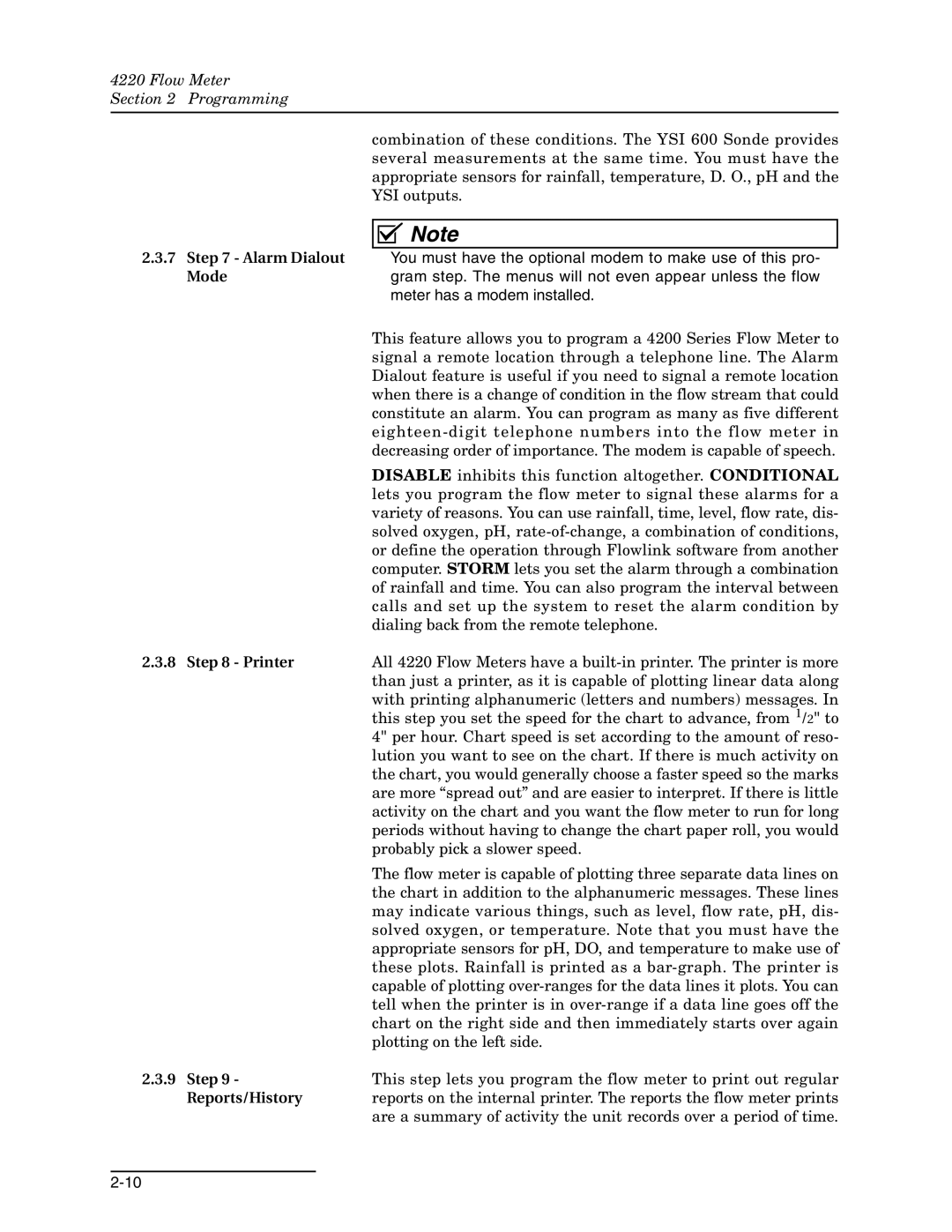
4220 Flow Meter
Section 2 Programming
combination of these conditions. The YSI 600 Sonde provides several measurements at the same time. You must have the appropriate sensors for rainfall, temperature, D. O., pH and the YSI outputs.
![]()
![]()
![]()
![]()
![]() Note
Note
2.3.7Step 7 - Alarm Dialout You must have the optional modem to make use of this pro-
| Mode | gram step. The menus will not even appear unless the flow |
|
| meter has a modem installed. |
|
| This feature allows you to program a 4200 Series Flow Meter to |
|
| signal a remote location through a telephone line. The Alarm |
|
| Dialout feature is useful if you need to signal a remote location |
|
| when there is a change of condition in the flow stream that could |
|
| constitute an alarm. You can program as many as five different |
|
| |
|
| decreasing order of importance. The modem is capable of speech. |
|
| DISABLE inhibits this function altogether. CONDITIONAL |
|
| lets you program the flow meter to signal these alarms for a |
|
| variety of reasons. You can use rainfall, time, level, flow rate, dis- |
|
| solved oxygen, pH, |
|
| or define the operation through Flowlink software from another |
|
| computer. STORM lets you set the alarm through a combination |
|
| of rainfall and time. You can also program the interval between |
|
| calls and set up the system to reset the alarm condition by |
|
| dialing back from the remote telephone. |
2.3.8 | Step 8 - Printer | All 4220 Flow Meters have a |
|
| than just a printer, as it is capable of plotting linear data along |
|
| with printing alphanumeric (letters and numbers) messages. In |
|
| this step you set the speed for the chart to advance, from 1/2" to |
|
| 4" per hour. Chart speed is set according to the amount of reso- |
|
| lution you want to see on the chart. If there is much activity on |
|
| the chart, you would generally choose a faster speed so the marks |
|
| are more “spread out” and are easier to interpret. If there is little |
|
| activity on the chart and you want the flow meter to run for long |
|
| periods without having to change the chart paper roll, you would |
|
| probably pick a slower speed. |
|
| The flow meter is capable of plotting three separate data lines on |
|
| the chart in addition to the alphanumeric messages. These lines |
|
| may indicate various things, such as level, flow rate, pH, dis- |
|
| solved oxygen, or temperature. Note that you must have the |
|
| appropriate sensors for pH, DO, and temperature to make use of |
|
| these plots. Rainfall is printed as a |
|
| capable of plotting |
|
| tell when the printer is in |
|
| chart on the right side and then immediately starts over again |
|
| plotting on the left side. |
2.3.9 | Step 9 - | This step lets you program the flow meter to print out regular |
| Reports/History | reports on the internal printer. The reports the flow meter prints |
|
| are a summary of activity the unit records over a period of time. |
